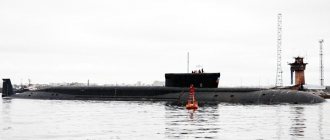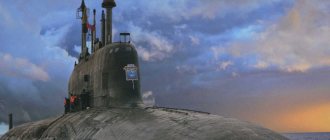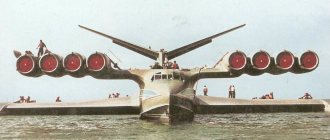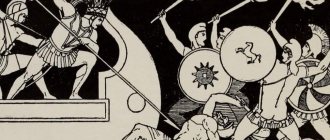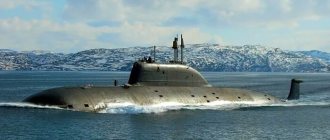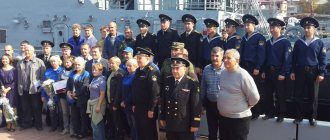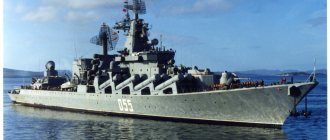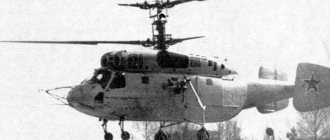Main objectives of the Project 945 nuclear submarine
The Los Angeles-class multi-purpose nuclear submarine, which appeared in the US Navy, allowed the Americans to gain dominance in the ocean for a short time.
The 2nd generation submarines, which had previously been the main type of weapons, were significantly inferior in many technical parameters to the new American ships. At some point, the USSR found itself defenseless against the threat of a breakthrough of the country’s maritime borders by the submarine forces of a potential enemy. Only timely and adequate measures on the part of the Soviet military-industrial complex could turn the situation back to its previous direction. The Project 945 submarine, which received the name “Sierra I” according to Western classification, was created with one sole purpose - to promptly detect submarines of a potential enemy and be ready to destroy them. The new submarine had to have the necessary stealth, high speed and great firepower.
Initially, the technical specifications for the new ship outlined the mandatory conditions that the new submarine must have. The hull must be double with the most efficient, from the point of view of hydrodynamics, contours. The power plant must have one nuclear reactor of reduced size, which will provide the ship with high speed characteristics.
In addition to the high technical characteristics of the new ships, a mandatory condition was set before the creators of the project. All ships of the new series must have a displacement and dimensions that fit into the parameters of the capacities of the ship repair and shipbuilding industry of the USSR. The task set before Soviet designers in 1972 included the construction of a new 3rd generation submarine in the next 3-5 years. For this purpose, the terms of reference provided for the development at the Lazurit Central Design Bureau, located in Gorky, of a project for the subsequent construction of nuclear submarines. The terms of reference provided for the construction of submarines on a competitive basis. In parallel with the development of Project 945, intensive work was underway on another project. Based on the same technical specifications and sketch data, SKB Malakhit was designing its own ship, the multi-purpose submarine of the Pike type - Project 971.
Ship hull
Multipurpose submarines of the Barracuda type were built with double hulls. This concept not only increased the tactical and technical characteristics of ships, but also made it possible to rationally use the technical capabilities of a titanium alloy. The main hull was made entirely of titanium, while the bow and stern ends of the boat's hull were of steel construction. The shape of the light hull had perfect hydrodynamic contours - an ellipsoidal bow and a spindle-shaped stern. The robust main hull had a conical shape, both at the bow and at the stern. All bulkheads at the ends of the ship were spherical, and the fastenings of the structure could easily experience the bending stresses that arise in the hull when diving to depth.
The entire ship was divided into 6 combat compartments. Ballast tanks were equipped with scupper-type kingstones. In addition, the design of the ship provided for the installation of an emergency ascent system. The tanks were purged not with compressed air, but with fuel combustion products during the operation of auxiliary diesel engines. To evacuate the crew in emergency situations, the boat was equipped with a rescue capsule installed in the area of the central combat post. The new boat had a practical diving depth of 480 m, while the maximum permissible diving limit reached 550 m.
The main weapon of the Project 945 submarine was the TEST-71 torpedo, the warhead of which could cause critical damage to a potential enemy ship. The new torpedo had an active-passive homing system, which made its movement almost invisible to the enemy.
The radio-electronic armament of the Barracuda-class submarines consisted of the SKAT sonar system. Low noise when the ship moves underwater and the presence of new hydroacoustic equipment increased the stealth of the ship. The accuracy of determining the ship's coordinates using new equipment has increased 5 times. The range of direct communication between the ship and the base has increased several times, exceeding the previous indicators for the Soviet submarine fleet by 2-3 times.
Design features of Project 971 nuclear submarines
Project 971 nuclear submarines were initially built as fighters of enemy submarine missile carriers, so powerful weapons were installed on the ships.
In terms of combat potential, modern “Pikes” were significantly superior to all domestic analogues and were much stronger than foreign combat submarines of the same class. https://youtube.com/watch?v=hqfcWJAAOT4
Together with the Barracuda-class submarines, the new attack nuclear submarines were supposed to form the backbone of the USSR Navy to counter the potential enemy’s naval strike groups on the Northern and Eastern flanks. Using their high tactical and technical characteristics, stealth and greater autonomy, the new “Pikes” could be successfully used for special operations throughout the world’s oceans.
The main design features of Project 971 nuclear-powered ships were the complete automation of the main technological and combat processes. All control of the ship was concentrated in a single main command post. The automation system for ship processes and control made it possible to significantly reduce the crew on the Project 971 Pike. The warship was served by 73 sailors and officers, which is almost two times less than on the main multi-purpose nuclear submarine of the US Navy Los Angeles class. The living conditions of the personnel on the new ships have also improved, and the living conditions for the crew at sea for a long time have improved.
One of the innovative solutions applicable to the design of the ship is the organization of a rescue system for the ship’s crew in emergency situations. Boats of the Shchuka-B type were equipped with a pop-up rescue chamber designed for the entire crew (73 people).
https://youtube.com/watch?v=bL8kPxFfWdc
Hull and power plant of the nuclear submarine "Pike"
The first nuclear-powered icebreaker of Project 971, the Shchuka-B type, was a double-hulled ship. The main strong hull of the ship is steel, made of high-strength steel. The hull of the boat was divided into compartments in such a way that all combat posts and main control units of the ship were located in separate isolated areas. The interior of the boat had a frame, stacked structure with passages and decks. Due to the two-stage depreciation of each block, it was possible to achieve a significant reduction in production noise and reduce the acoustic signal emitted by working mechanisms and the crew. Each block in the ship was isolated from the pressure hull by pneumatic shock absorbers, creating a second level of vibration isolation.
For example, on the Northern Fleet submarine K-317 “Panther”, rubber shock absorbers and silicone gaskets were tested for the first time on the main operating mechanisms. As a result, the noise of the operating steam turbine unit of the nuclear reactor and electric motors decreased by 30-40%.
On all subsequent ships launched from the Sevmash slipways, parts and mechanisms made of synthetic materials were installed. The noise levels produced by Project 971 submarines of the Northern Fleet remain the lowest today.
During the construction of the boats, the technology of block assembly of the main ship structures was used. Installation of equipment was now carried out not in the cramped conditions of the boat hull, but directly on stands in the factory workshops. Upon completion of assembly, the unit was installed in the ship’s hull, after which it was connected to the main communications of the boat. Innovations introduced into the project, the presence of a rescue chamber for the crew and a hull made of high-strength steel led to an increase in the ship's displacement to 8 thousand tons.
The ship's propulsion system and energy supply system were based on the operation of one OK-650B nuclear reactor, which communicated with four steam generators. As a backup power unit, a single-shaft steam turbine was installed on the boat, which had a full backup set of mechanization for all processes. The total power of the power plant is 50 thousand hp. As a result, the nuclear-powered ship could develop a surface speed of 11 knots, and under water, at least 33 knots.
The backup power plant consisted of two DG-300 diesel engines, which provided power supply and propulsion of the ship in emergency situations. The supply of diesel fuel was designed for a 10-day voyage on reserve engines.
This is a holiday for all of Russia
On Navy Day, which the country celebrated last Sunday, Supreme Commander-in-Chief of the Russian Armed Forces Vladimir Putin visited the main base of the Red Banner Northern Fleet, Severomorsk. Walking around the formation of Northern Fleet warships on a boat, he congratulated the crews on their professional holiday. Then, from the heavy aircraft-carrying cruiser Admiral of the Fleet of the Soviet Union Kuznetsov, via videoconference, he received a report from Severodvinsk from Deputy Prime Minister of the Russian Federation Dmitry Rogozin and Deputy Minister of Defense of the Russian Federation Yuri Borisov on the laying down of new nuclear submarines at the Sevmash Production Association.
There are not enough funds to modernize the titanium "Karp"
The modernization of the Karp nuclear submarine has been suspended indefinitely; the work is not funded, TASS reports, citing a source in the military-industrial complex. The Russian Ministry of Defense ordered the repair of two titanium submarines of Project 945 Barracuda in December 2012. In the spring of 2014, Zvezdochka began preparations for a deep modernization of the first of them, Karp. “To date, the Ministry of Defense has not yet received any documents clarifying the fate of this contract, but its financing is no longer being carried out, and all work on the project has been suspended as of today,” the agency’s interlocutor said.
The appearance of Project 945A submarines
After improving the power plant and strengthening the ships’ armament based on the existing project, new Project 945A Condor-type submarines appeared. Even at the stage of laying the 3rd and 4th ships of the series, an attempt was made to prepare the ships for the installation of the modernized OK-650B reactor. The power of the power plant increased to 48 thousand hp. New thrusters were installed on the boats, improving the maneuverability of the ship in combat conditions. The size of the ships remained unchanged, but their displacement increased to 6,400 tons. The submarine's crew is still 61 people. The main changes in the design affected the combat capabilities of the new ships. The introduction of design changes to the ship's weapon system led to the fact that on Project 945A boats the number of compartments reached 7.
The submarines were armed with six 533-mm torpedo tubes. However, the main weapon of the warship was the Granat strategic cruise missiles. One submarine carried up to 10 missiles with conventional and nuclear warheads. The launch of cruise missiles was to be carried out through torpedo tubes. Condor-class ships were armed with Igla MANPADS, which strengthened the air defense system of military ships.
The second ship of the Okun nuclear submarine series was laid down in 1989 and entered service in 1992, joining the ranks of the Russian Navy. In 1995, the boat received a new name, becoming the nuclear submarine Pskov. Further construction of new submarines was stopped. The next modernization of the ships' combat capabilities led to the laying of the Project 945B submarine (code "Mars"). However, due to the difficult financial situation in the country, it was decided not to build expensive titanium submarines in the future.
Today, the Russian Navy's roster includes all four titanium submarines. The submarines "Tula" and "Kostroma" are located at the wall of the shipyard, awaiting their future fate. Newer ships, the submarine Pskov and its sister, the nuclear submarine Nizhny Novgorod, are included in the 7th submarine division of the Northern Fleet, based in Vidyaevo. It is planned to re-equip all four ships in accordance with the technical specifications of Project 945M and arm the ships with Caliber cruise missiles.
An excerpt characterizing Project 945 Barracuda submarines
The sun has long since set. Bright stars lit up here and there in the sky; The red, fire-like glow of the rising full moon spread across the edge of the sky, and a huge red ball swayed amazingly in the grayish haze. It was getting light. The evening was already over, but the night had not yet begun. Pierre got up from his new comrades and walked between the fires to the other side of the road, where, he was told, the captured soldiers were standing. He wanted to talk to them. On the road, a French guard stopped him and ordered him to turn back. Pierre returned, but not to the fire, to his comrades, but to the unharnessed cart, which had no one. He crossed his legs and lowered his head, sat down on the cold ground near the wheel of the cart and sat motionless for a long time, thinking. More than an hour passed. Nobody bothered Pierre. Suddenly he laughed his fat, good-natured laugh so loudly that people from different directions looked back in surprise at this strange, obviously lonely laugh. - Ha, ha, ha! – Pierre laughed. And he said out loud to himself: “The soldier didn’t let me in.” They caught me, they locked me up. They are holding me captive. Who me? Me! Me - my immortal soul! Ha, ha, ha!.. Ha, ha, ha!.. - he laughed with tears welling up in his eyes. Some man stood up and came up to see what this strange big man was laughing about. Pierre stopped laughing, stood up, moved away from the curious man and looked around him. Previously loudly noisy with the crackling of fires and the chatter of people, the huge, endless bivouac fell silent; the red lights of the fires went out and turned pale. A full moon stood high in the bright sky. Forests and fields, previously invisible outside the camp, now opened up in the distance. And even further away from these forests and fields one could see a bright, wavering, endless distance calling into itself. Pierre looked into the sky, into the depths of the receding, playing stars. “And all this is mine, and all this is in me, and all this is me! - thought Pierre. “And they caught all this and put it in a booth fenced off with boards!” He smiled and went to bed with his comrades. In the first days of October, another envoy came to Kutuzov with a letter from Napoleon and a peace proposal, deceptively indicated from Moscow, while Napoleon was already not far ahead of Kutuzov, on the old Kaluga road. Kutuzov responded to this letter in the same way as to the first one sent with Lauriston: he said that there could be no talk of peace. Soon after this, from the partisan detachment of Dorokhov, who went to the left of Tarutin, a report was received that troops had appeared in Fominskoye, that these troops consisted of the Broussier division and that this division, separated from other troops, could easily be exterminated. The soldiers and officers again demanded action. The staff generals, excited by the memory of the ease of victory at Tarutin, insisted to Kutuzov that Dorokhov’s proposal be implemented. Kutuzov did not consider any offensive necessary. What happened was the mean, what had to happen; A small detachment was sent to Fominskoye, which was supposed to attack Brusier. By a strange coincidence, this appointment - the most difficult and most important, as it turned out later - was received by Dokhturov; that same modest, little Dokhturov, whom no one described to us as drawing up battle plans, flying in front of regiments, throwing crosses at batteries, etc., who was considered and called indecisive and uninsightful, but the same Dokhturov, whom during all Russian wars with the French, from Austerlitz until the thirteenth year, we find ourselves in charge wherever the situation is difficult. In Austerlitz, he remains the last at the Augest dam, gathering regiments, saving what he can, when everything is running and dying and not a single general is in the rearguard. He, sick with a fever, goes to Smolensk with twenty thousand to defend the city against the entire Napoleonic army. In Smolensk, as soon as he dozed off at the Molokhov Gate, in a paroxysm of fever, he was awakened by cannonade across Smolensk, and Smolensk held out all day. On Borodino Day, when Bagration was killed and the troops of our left flank were killed in a ratio of 9 to 1 and the entire force of the French artillery was sent there, no one else was sent, namely the indecisive and indiscernible Dokhturov, and Kutuzov hurries to correct his mistake when he sent there another. And small, quiet Dokhturov goes there, and Borodino is the best glory of the Russian army. And many heroes are described to us in poetry and prose, but almost not a word about Dokhturov. Again Dokhturov is sent there to Fominskoye and from there to Maly Yaroslavets, to the place where the last battle with the French took place, and to the place from which, obviously, the death of the French already begins, and again many geniuses and heroes are described to us during this period of the campaign , but not a word about Dokhturov, or very little, or doubtful. This silence about Dokhturov most obviously proves his merits. Naturally, for a person who does not understand the movement of a machine, when he sees its action, it seems that the most important part of this machine is that chip that accidentally fell into it and, interfering with its progress, flutters in it. A person who does not know the structure of the machine cannot understand that it is not this splinter that spoils and interferes with the work, but that small transmission gear that silently turns, is one of the most essential parts of the machine. On October 10, the same day that Dokhturov walked half the road to Fominsky and stopped in the village of Aristov, preparing to exactly carry out the given order, the entire French army, in its convulsive movement, reached Murat’s position, as it seemed, in order to give The battle suddenly, for no reason, turned left onto the new Kaluga road and began to enter Fominskoye, in which Brusier had previously stood alone. Dokhturov at that time had under his command, in addition to Dorokhov, two small detachments of Figner and Seslavin. On the evening of October 11, Seslavin arrived in Aristovo to his superiors with a captured French guardsman. The prisoner said that the troops that had entered Fominskoe today constituted the vanguard of the entire large army, that Napoleon was right there, that the entire army had already left Moscow for the fifth day. That same evening, a servant who came from Borovsk told how he saw a huge army entering the city. Cossacks from Dorokhov's detachment reported that they saw the French Guard walking along the road to Borovsk. From all this news it became obvious that where they thought they would find one division, there was now the entire French army, marching from Moscow in an unexpected direction - along the old Kaluga road. Dokhturov did not want to do anything, since it was not clear to him now what his responsibility was. He was ordered to attack Fominskoye. But in Fominskoe there had previously only been Broussier, now there was the entire French army. Ermolov wanted to act at his own discretion, but Dokhturov insisted that he needed to have an order from His Serene Highness. It was decided to send a report to headquarters. For this purpose, an intelligent officer was elected, Bolkhovitinov, who, in addition to the written report, had to tell the whole matter in words. At twelve o'clock at night, Bolkhovitinov, having received an envelope and a verbal order, galloped, accompanied by a Cossack, with spare horses to the main headquarters. The night was dark, warm, autumn. It had been raining for four days now. Having changed horses twice and galloping thirty miles along a muddy, sticky road in an hour and a half, Bolkhovitinov was in Letashevka at two o'clock in the morning. Having dismounted from the hut, on the fence of which there was a sign: “General Headquarters,” and abandoning his horse, he entered the dark vestibule. - The general on duty, quickly! Very important! - he said to someone who was rising and snoring in the darkness of the entryway. “We’ve been very unwell since the evening; we haven’t slept for three nights,” the orderly’s voice whispered intercessively. - You must wake up the captain first. “Very important, from General Dokhturov,” said Bolkhovitinov, entering the open door he felt. The orderly walked ahead of him and began to wake up someone: “Your honor, your honor is the courier.” - I'm sorry, what? from whom? – said someone’s sleepy voice. – From Dokhturov and from Alexey Petrovich. “Napoleon is in Fominskoye,” said Bolkhovitinov, not seeing in the darkness who asked him, but by the sound of his voice, suggesting that it was not Konovnitsyn. The awakened man yawned and stretched. “I don’t want to wake him up,” he said, feeling something. - You're sick! Maybe so, rumors. “Here’s the report,” said Bolkhovitinov, “I’ve been ordered to hand it over to the general on duty immediately.” - Wait, I’ll light a fire. Where the hell do you always put it? – turning to the orderly, said the stretching man. It was Shcherbinin, Konovnitsyn's adjutant. “I found it, I found it,” he added. The orderly was chopping the fire, Shcherbinin was feeling the candlestick. “Oh, disgusting ones,” he said with disgust. In the light of the sparks, Bolkhovitinov saw the young face of Shcherbinin with a candle and in the front corner a still sleeping man. It was Konovnitsyn. When the brimstones lit up with a blue and then a red flame on the tinder, Shcherbinin lit a tallow candle, from the candlestick of which the Prussians ran, gnawing it, and examined the messenger. Bolkhovitinov was covered in dirt and, wiping himself with his sleeve, smeared it on his face. -Who is informing? - said Shcherbinin, taking the envelope. “The news is true,” said Bolkhovitinov. - And the prisoners, and the Cossacks, and the spies - they all unanimously show the same thing. “There’s nothing to do, we have to wake him up,” said Shcherbinin, getting up and approaching a man in a nightcap, covered with an overcoat. - Pyotr Petrovich! - he said. Konovnitsyn did not move. - To the main headquarters! – he said, smiling, knowing that these words would probably wake him up. And indeed, the head in the nightcap rose immediately. On Konovnitsyn’s handsome, firm face, with feverishly inflamed cheeks, for a moment there remained the expression of dreams of a dream far from the present situation, but then suddenly he shuddered: his face took on its usually calm and firm expression.
History of creation
When designing second-generation multi-purpose nuclear submarines, the country's leading design bureaus and research centers simultaneously carried out work on third-generation nuclear submarines. The main reason for this was the dynamic development of the American submarine fleet, which in turn required a response from the Soviet Navy
As part of the country's anti-submarine defense concept, third-generation multipurpose submarines received special attention due to their increased search capabilities. They were considered as the main means of detecting enemy submarines, tracking them and destroying them, if the appropriate order was received.
In March 1972, tactical and technical assignments were given for the development of a Project 945 nuclear submarine under the code "Barracuda". N.I. Kvasha was appointed chief designer. The main tasks for the boats of the new project were to track strategic submarines and aircraft carrier strike groups of a potential enemy and ensure their destruction at the outbreak of a conflict. The main limitation was displacement, since construction was planned at domestic factories in the country.
An important part of the project was the creation of a durable titanium alloy body. This made it possible to increase the maximum depth by one and a half times compared to second generation boats
Also, the use of an alloy of high specific strength made it possible to reduce the displacement of the boat, which made construction possible on and subsequent transportation by inland waterways. Also, the titanium structure greatly reduced the ship's magnetic field. According to this indicator, boats 945 of the project still maintain world leadership. The only disadvantage of boats made of titanium alloys was their price. For this reason, the number of ships in the series was limited in favor of cheaper Project 971 Shchuka-B nuclear submarines, which used low-magnetic steel.
LitLife
Ilya Kramnik
Types of Soviet submarines
In various scientific (and not so scientific) works and discussions, complaints are often expressed about the diversity of ships of the Soviet fleet and its imbalance. First of all, the submarine fleet is divided into two categories: ocean - designed for active operations at a great distance from bases - and sea, designed for operations primarily in closed and coastal theaters. This second component was provided by diesel submarines from Project 613 onwards, and the first, ocean-going, arose in the mid-late 50s simultaneously with the birth of the nuclear submarine, but was first tested on diesel submarines in the ocean zone.
PL. project 613
So, what is an ocean-going Soviet submarine? These are three classes of boats:
1. SSBNs - designed to deliver a nuclear strike on enemy territory.
2. SSGNs - designed to destroy large enemy surface ships with anti-ship missiles (and more specifically, aircraft carriers of the US and British Navy).
3. SSNs (MSNAS) are multi-purpose submarines with torpedo armament, designed to destroy enemy submarines and NK with torpedoes.
This triad is clearly preserved throughout the existence of the Soviet (Russian) submarine, and is divided into three generations: the first - the end of the 50s - the end of the 60s, the second - the end of the 60s - the turn of the 70s-80s , third - the turn of the 70s-80s-late 90s. In each of these generations, each class is represented by ONE, maximum - and there is only one exception - TWO RELATED boat projects, to which improvements are made during construction (marked by letters behind the digital designation of the project). Another exception is the “political project” SSBN 941.
Project 941-TPK strategic purpose
Severodvinsk-Yagrinsky beach
In addition, to test certain innovations, small-scale and single boats are built according to special projects, but they do not violate the overall picture. So, let’s look at all generations one by one, but let’s start with “generation zero” - a triad of ocean-going diesel-electric submarines that were built to test new technologies for underwater shipbuilding and/or eliminate the “hole” that arose due to our lag behind the United States in commissioning nuclear submarines. Everything here is simple and strict. Three classes - three projects
SSBN - Project 629, NATO designation “Golf”, 23 of them were built in 1958-62, which bore the main burden of providing the naval part of nuclear deterrence until the final development of the 1st generation nuclear SSBNs (mid-60s) . In the 70s, these boats were mostly decommissioned; several copies were used to test new missiles. K-129 was lost on March 8, 1968 during a firefight near the Hawaiian Islands, presumably as a result of a collision with the US Navy submarine Swordfish.
Project 629 - ballistic missile submarine
SSGN (letter A - nuclear - absent) - project 651, NATO designation "JULIETT", were built in parallel with nuclear boats of this class of the 1st generation, due to the fact that the nuclear shipbuilding capacity was not enough to build the required number of SSGNs, as a result The “hole” was plugged with diesel-electric submarines. In addition, proven technologies of diesel-electric submarines made it possible to quickly introduce them into the composition and use them with greater intensity than new and not fully developed nuclear submarines. Project 651 was reproduced in 16 copies in 1960-68.
Project 651 - large submarine with cruise missiles code Kasatka
SSN (here A - attacking) - project 641, NATO designation “FOXTROT”, the boat bore the brunt of the confrontation during the Cuban Missile Crisis and other aggravations of the 60s. 24 of them were built in 57-64, and another 16 were built for export.
Project 641 - large submarine. Foxtrot code
photo of Ukrainian submarine pr.641.Zaporozhye
Experimental and experienced submarines in the “generation zero” were mainly converted from “combat” projects. Almost in parallel with the triad of ocean-going diesel submarines, a nuclear submarine triad is being born. The first nuclear submarine of the USSR Navy entered service in 1957. Ten years will pass, and the nuclear submarine will take on the main burden of the ocean confrontation. In the meantime, they are learning. So, the first generation triad:
SSBN - Project 658, NATO designation "Hotel". Their construction was carried out in 1958-64, 8 boats were built, the first submarine of this type entered combat service in 1962 (the same K-19). Compare with Project 629 - construction also began in 1958, but the first boat entered the BS already in 1959 - the proven technology provides a number of advantages, although it is inferior to the new one in terms of combat capabilities.
Project 658 - nuclear submarine with ballistic missiles
SSGN - project 659 and its related project 675 (the same exception - two combat projects). However, their relationship was noted by NATO, encrypted with one code - “Eсho”. Echo I and II. Construction of Project 659 with the P-5 missile system was carried out in 1957-62; boats began to operate on the BS in 1962, a year later than the diesel Project 651, which began construction in 1960. Due to the low efficiency of the P-5 missile system 5 in the late 60s, Project 659 boats were rebuilt into submarines. Project 675 with the P-6 missile system was built in 1961-67. on BS - since 1965, 29 submarines were built, remained in service for a long time, and were re-equipped with new complexes - P-6 - P-35 "Progress" - P-500 "Basalt" - P-1000 "Vulcan" already at the beginning 80s The last boats of this project were put out of service only in the mid-90s.
Project 659 - nuclear submarine with cruise missiles
Project 675-atomic submarine cruiser with cruise missiles code Akula
PLA - project 627 (head) and 627A - series, NATO designation “November”. However, the name quickly became a household name. “The November project could also be heard from Soviet admirals - this is such a significant month for our country. The first-born of Soviet nuclear shipbuilding, an extremely successful submarine with powerful weapons and excellent performance characteristics. Construction began in 1954, the first boat was commissioned in 1957, the series was completed in 1963, the first launch of boats of this type on the BS was 1961. In total, 13 boats were built according to project 627 and 627A, which were in service until 1991-92.
Construction[ | code]
Housing | code
The boat is built using a double-hull design. The light hull at the bow of the boat has an ellipsoidal tip, and at the stern it has a spindle-shaped tip. The durable body is made of titanium alloy and has a cylindrical shape in the middle and conical at the ends. It consists of 6 waterproof compartments. The submarine has a pop-up escape capsule that can accommodate the entire crew.
Powerplant | code
The main power plant is one OK-650A pressurized water reactor with a capacity of 43,000 hp. With. and one turbo gear unit. A reactor of this type has four steam generators, two circulation pumps each for the first and fourth circuits, and three pumps for the third circuit. The boat has two AC turbo generators, two feed pumps and two condenser pumps. There are also two groups of batteries and two reversible converters.
Armament | code
The project's boats are armed with a torpedo-missile system, which allows firing without restrictions on diving depth and includes four 533-mm and two 650-mm torpedo tubes. The ammunition capacity is 40 torpedoes and missiles.
Conventional torpedoes of various types, missile-torpedoes of the Vodopad anti-submarine missile system, and Veter anti-submarine missiles, capable of installing a nuclear warhead, can be used as ammunition for torpedo tubes.
Electronic equipment | code
Among the radio-electronic equipment on the boats of the project, the MGK-503 Skat sonar system was installed. Thanks to the reduction of the sonar system's own interference and the noise of the boat, which was significantly lower compared to boats of the previous generation, the target detection range more than doubled. The number of errors when determining the location of the boat was reduced, which made it possible to surface much less frequently to determine coordinates. New communication equipment made it possible to increase the signal reception range and their depth.
Modifications | code
945A "Condor" | code
Main article: Project 945A Condor submarines
Submarines of the improved Project 945A "Condor" had differences in the weapons complex, a new reactor and thrusters. Measures have also been taken to achieve even lower noise levels.
945B "Mars" | code
Main article: Mars (submarine)
A modification of the Barracuda project boats, which has almost the same characteristics for fourth-generation nuclear submarines. Due to a decrease in defense spending after the collapse of the USSR, construction of the only boat of the modified project laid down was stopped.
Modernization | code
It is planned to modernize both ships at the Zvezdochka CS according to Project 945M:
- replacement of nuclear fuel;
- replacement of all electrical equipment;
- inspection and repair of mechanical parts of ships;
- if necessary, reactors will also be repaired;
new ones will be installed:
- GAS;
- BIUS,
- radars,
- GLONASS/GPS navigation systems;
- weapon systems:
Breakthrough to the West: what Russian submariners did in the Atlantic
Northern Fleet exercises are the largest since the Soviet Union
This week, Norwegian media reported that there are about 10 submarines of the Russian Northern Fleet in the North Atlantic, eight of which are nuclear. In their opinion, the submariners were practicing breaking through the Faroe-Icelandic anti-submarine line and covert deployment in the waters of the Atlantic
Prime Minister Erna Solberg commented on the situation: Russia is thereby demonstrating its power and the importance of ensuring the security of the sea route towards Murmansk. She noted that Norway does not see this as a threat, but needs NATO defense
The Russian Ministry of Defense responded with a statement: “The Russian military is conducting planned combat operational training activities.” Izvestia looked into what it meant for so many submarines to go to sea and what tasks they could solve.
Service history[ | code]
The first boat of the K-239 “Karp” project began its service in 1984. In 1998, after only 14 years of service, she was decommissioned and her future fate remains in doubt. The second, K-276 "Crab", entered combat service in 1987. On February 11, 1992, in Russian territorial waters, she collided with the American Los Angeles-class submarine Baton Rouge. The Crab's wheelhouse, designed to break through ice, was slightly damaged, and the Baton Rouge had a fire after the collision. After the accident, the Baton Rouge nuclear submarine reached the base under its own power and was decommissioned after some time.
Comparative assessment | code
| "Los Angeles" | "Pike" | "Pike-B" | "Barracuda" | "Condor" | "Fin" | "Ruby" | |
| Appearance | |||||||
| Years of construction | — | — | — | — | — | — | — |
| Years of service | c | c | c | c | c | c— | c |
| Built | 62 | 15 | 15 | 2 | 2 | 1 | 6 |
| Displacement (t) surface underwater | 6082 7177 | 6990 7250 | 8140 12770 | 5940 9600 | 6470 10400 | 5880 8500 | 2410 2607 |
| Speed (kt) surface underwater | 17 30-35 | 11,6 31 | 11,6 33 | 19 35 | 19 35 | 11 33 | 15 25 |
| Immersion depth (m) working limit | 280 450 | 400 600 | 480 600 | 480 550 | 520 600 | 10001250 | 300 |
Characteristics
Below are the characteristics of the Project 949A nuclear submarine:
- displacement above, m.cub. – 12500;
- underwater displacement, cubic meters – 22500;
- power plant - 2 × OK-650 (with a power of 2 x 190 MW);
- surface speed, knots – 15;
- underwater speed, knots – 32;
- Max. immersion depth, m – 600;
- autonomy, days – 120;
- crew, people – 94;
- armament - 24 anti-ship missiles "Granit", TA 650 mm - 4 pcs., TA 533 mm - 4 pcs.
Author of the article:
Egorov Dmitry
I am interested in military history, military equipment, weapons and other issues related to the army. I love the written word in all its forms.
